Last Updated on January 17, 2024 by Greg Gillson
Ohio is a great place to set up a winter bird feeder. If you want to join in with others in this joyful pastime, you have come to the right place!
This article tells all about how and why to feed winter birds in Ohio. It also shows you pictures of some of the common winter feeder birds you can expect, along with brief identification. And this page tells you what foods to offer in order to attract these birds to your backyard.
Winter weather in Ohio is cold, very cold. Temperatures are slightly warmer as one moves south in the state. But that is relative. The average low temperature for the state in January is 15˚ F (-9.4˚ C). Snowfall amounts are also deeper in the north (especially the northeast) than in the south.
You might think that birds would be absent in these harsh winter conditions. But no. There are many birds in Ohio in winter, even in your backyard. But with snow frequently covering the natural food, birds will quickly come to your bird feeder!
Why feed winter birds in Ohio?
Many bird species spend the winter in Ohio. And many people feed birds in winter. In fact, because people feed birds, more bird numbers spend the winter in towns now than in the past. Many birds rely on some bird feeders to supplement their winter diet.
Even if many of the individual birds could survive winter without bird feeders, many do so more easily thanks to people like you who feed them.
Some of the birds that really benefit from backyard feeders are the young-of-the-year. These birds, only 6 months old or so, are experiencing their first Ohio winter! They lack the experience of older birds at finding food and water in cold and snowy conditions. Your feeders can really make a difference to these individuals.
Do the birds need us to feed them? Probably not. Or, usually not.
Do we need to feed birds? Maybe so. Feeding birds brings us closer to nature and is good for our mental health. Watching birds at our feeders can relieve stress. It gives us joy, even on dreary days. You never know what new species may show up at your feeder, especially early in winter.
What birds come to feeders in Ohio in winter?
Fortunately for bird lovers, Ohio has many interesting birds that come to feeders in winter.
Following are a few photos and descriptions of the more common birds to visit your feeders. For a more complete list, including birds that visit your backyard at other times of year, please see my article on the common backyard birds of Ohio. I’ll link to it again at the end of this article to remind you.
The summaries below list basic identification and tell what kind of foods each bird likes best. I also list the kind of bird feeders that the species prefers.
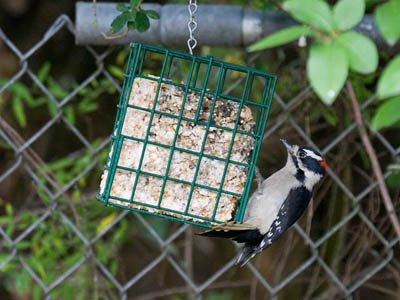 |
| Downy Woodpecker Photo by Greg Gillson |
Downy Woodpecker:
This tiny woodpecker is common in deciduous woods and backyards.
They are common across North America from Alaska and across Canada and south through the United States. They stay away from the deserts of the West and Southwest, though. They are found year-round throughout Ohio.
Small and stocky, they have a very small chisel-pointed bill. They are black-and-white striped on the head. The wings and tail are black with white bars. The under parts are white. The back is white. Males have a small red spot on the nape.
They give a pik call and a rattle call in spring.
Downy Woodpeckers love suet in backyard feeders.
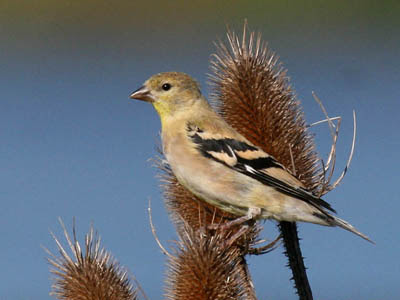 |
| American Goldfinch Photo by Greg Gillson |
American Goldfinch:
These birds love weedy grasslands and backyard feeders.
In summer they live across southern Canada and the northern 1/2 of the United States. In winter they mostly leave Canada and may be found throughout all of the U.S. They live year-round in Ohio.
These are tiny birds, rather slim with short forked tails. The conical seed-eating bill is small. Males in summer are bright yellow with black wings and tail. In winter birds molt into a dull tan plumage with a bit of yellow on the throat. The black wings and tail have large pale edges.
Flight calls are a cheery chirping po-ta-to-chip!
American Goldfinches visit backyard feeders for black oil sunflower seeds in tube feeders. They really love Niger seed in special thistle feeders.
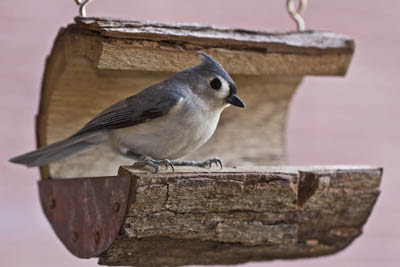 |
| Tufted Titmouse Image by anne773 from Pixabay |
Tufted Titmouse:
These relatives of chickadees live in deciduous woodlands in the eastern half of the United States. They live year-round in Ohio.
They are stocky with a big head and full tail. The bill is stout, though small. They are colored blue-gray above and pale gray below. There is a ring of black feathers around the eye and on the forehead.
They give a loud Peter Peter Peter song throughout the year and also chickadee-like calls.
Tufted Titmouses love to eat black oil sunflower seeds from hopper feeders.
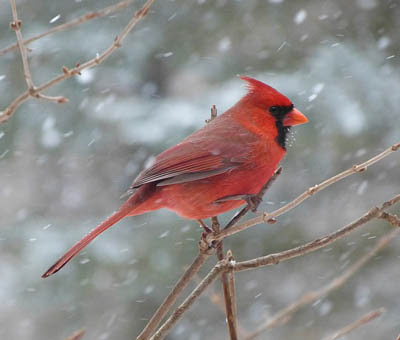 |
| Northern Cardinal Image by tlparadis from Pixabay |
Northern Cardinal:
These familiar birds of eastern and southeastern deciduous forests lights up many backyards. They are year-round residents throughout Ohio.
They have a distinctive crest and full tail. The bill is heavy and colored orange. Males are bright red with black face. Females are pale brown.
They are quite vocal and sing throughout the year. Common calls songs include a whistled whoit whoit whoit or birdy birdy.
Northern Cardinals eat larger seeds including safflower and sunflower seeds.
They prefer a feeder with a tray, so either a larger hopper feeder or platform feeder.
 |
| Mourning Dove Photo by Greg Gillson |
Mourning Dove:
These pigeons are found throughout the United States in towns and farmlands. They are found throughout Ohio at all times of year.
They are stocky with a small round head. The tail is long and pointed. They are colored a fawn brown, with a pinkish hue on the breast.
They give a mournful cooing song: boo-hoo hoo hoo.
Mourning Doves eat a wide variety of seeds and grain, including sunflower seeds, cracked corn, and mixed bird seed.
They like to eat on the ground or on platform feeders.
 |
| Dark-eyed Junco Photo by Greg Gillson |
Dark-eyed Junco:
Often called “snowbirds” because they arrive in backyards with the first snows.
They breed in conifer forests and mountains in Canada and the United States. In Ohio they breed in the northeastern corner of the state, but are only found in the winter in most of the state.
They are small and neckless with a thin tail that flashes white outer tail feathers. The form in Ohio is mostly slate gray with a white belly. Females show a bit of brown on the back.
They constantly twitter and smack as they feed.
The spring song is a long musical trill on a single pitch.
Dark-eyed Juncos feed on the ground and like mixed bird seed.
So they prefer platform feeders and hopper feeders.
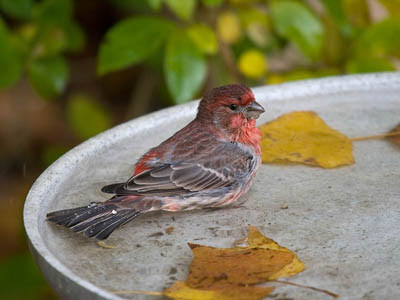 |
| House Finch Photo by Greg Gillson |
House Finch:
These birds are found in open lands in the West, but in residential areas and backyards throughout most of the United States. They are found year-round throughout Ohio.
They are small with prominent heads and long tails. They are brownish above and pale below, heavily streaked with dark brown. Males have a red forehead, breast, and rump.
They give a chirping call: wheat. The song is given throughout the year and is a lively warble of high-pitched three-part notes.
House Finches love black oil sunflower seeds which they eat from hopper feeders and tube feeders.
 |
| White-breasted Nuthatch Photo by Greg Gillson |
White-breasted Nuthatch:
These birds are found in oak and pine woodlands across the United States and southern Canada. They are year-round residents in Ohio.
They are small, stout birds with big heads and long straight bills. The tail is very short. These birds are gray above with a black crown. The under parts and face is white.
The common call is a nasal yank yank yank.
White-breasted Nuthatches grab black oil sunflower seeds one-at-a-time from tube feeders and then go off to a tree to pound the seeds open and eat them.
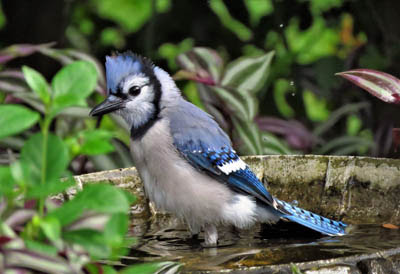 |
| Blue Jay Image by skeeze from Pixabay |
Blue Jay:
These boisterous birds are found in deciduous woods in eastern and central United States and central Canada. They are found throughout the year in Ohio.
Fairly large, they feature a large head with long stout bill and full tail.
They are blue above, including a full crest. The under parts and face are white. These birds have a black necklace across the throat that goes up around the back of the head. There are white patches in the wings and tail.
Calls include a raspy jay jay jay and whistled wheedle notes.
Blue Jays eat sunflower seeds and peanuts from hopper and platform feeders.
 |
| Red-bellied Woodpecker Image by skeeze from Pixabay |
Red-bellied Woodpecker:
These larger woodpeckers are found in open woodlands and towns across the eastern United States. They are found throughout Ohio.
Stocky with a short stiff pointed tail, they have a big head and long chisel-shaped bill. They cling to tree trunks with powerful feet.
The upperparts are black with numerous thin white bars. The under parts are pale gray. Both genders have red on the back of the neck, males have more red, continuing over the crown to the forehead.
They have a loud churrr call.
Red-bellied Woodpeckers eat sunflower seeds, peanuts, and other nuts from platform and large hopper feeders.
Setting up a winter bird feeding station in Ohio
So what kinds of feeders and what kind of foods will attract the most birds in winter in Ohio?
I suggest starting with a larger hopper feeder with a large roof to keep off the snow.
You can put in a mixed bird seed. But make sure it has plenty of black oil sunflower seeds and white proso millet. These should probably be listed as the first 2 ingredients.
Also make sure that milo isn’t listed as one of the first 4 to 5 ingredients. This filler seed isn’t well liked by most birds. They’ll toss it out of the feeder and make a mess.
This hopper feeder will attract the cardinals, juncos, doves, jays and many others.
Next, set up a tube feeder with black oil sunflower seeds exclusively. Both the red finches and the goldfinches love these. So will the nuthatches and titmouses.
If you want to attract woodpeckers then set up a suet feeder. Try a variety with nuts for them. Many birds will eat suet in the winter. You can experiment with several different additives, such as nuts, seeds, fruit, or even mealworms.
Finally, a bird bath with a heater will supply all birds with drinking water. They need this especially when all the available ground water is frozen. You may find birds come for a drink that don’t eat any of the foods you offer at your feeder.
Wrapping Up
Feeding birds in winter in Ohio can be a wonderful way to provide much-needed support to feathered friends during a challenging season.
Providing vital food sources: Natural food sources can be scarce in winter, especially when covered in snow or frozen. Offering readily available food can help birds maintain their energy levels and survive harsh weather conditions.
Attracting a variety of birds: Ohio boasts diverse bird populations, and winter feeders can draw in colorful species like cardinals, juncos, chickadees, goldfinches, and many more, adding delightful splashes of color to your backyard.
Creating a connection with nature: Watching and caring for birds can be a rewarding experience, fostering a sense of connection with the natural world right outside your window.
Frequently Asked Questions
What birds stay in Ohio year-round?
Many resilient avian residents grace Ohio with their presence year-round, braving the state’s changing seasons. Here are some other common feathered friends you might encounter throughout the year:
American Robin: Beloved for their melodious carols, these orange-breasted robins flit through trees and lawns, searching for berries and worms, even through winter.
Eastern Bluebird: These cerulean blue birds with rusty orange chests add a splash of color to winter landscapes, frequenting open fields and orchards.
Black-capped Chickadee: These acrobatic cuties with their distinctive “chick-a-dee” calls brighten winter gardens and feeders, flitting in search of seeds and insects.
Red-tailed Hawk: Soaring high above open fields and forests, these majestic raptors keep a watchful eye year-round, hunting for small rodents and rabbits.
Screech-Owl: These small owls with big eyes perch on tree branches, patiently waiting for nightfall to hunt insects and small mammals.
Do blue birds leave the Ohio for the winter?
Whether bluebirds leave Ohio for the winter or not depends on their individual circumstances and species:
Some stay: A portion of the Eastern Bluebird population in Ohio, particularly those in the southern regions, actually choose to remain year-round. They adapt to the colder temperatures by finding food sources like berries and suet, and finding shelter in cavities or nest boxes.
Some migrate: Bird populations, especially those further north in the state, often migrate south during the winter months. They might travel to states like Kentucky, Tennessee, or even the Gulf Coast in search of milder temperatures and more abundant food sources.
Factors influencing their decision:
Food availability: Availability of berries, insects, and other natural food sources plays a crucial role. If enough food remains accessible in Ohio, some bluebirds might choose to stay.
Temperature: Harsh winter conditions can push birds southward in search of milder temperatures.
Age and experience: Younger bluebirds are more likely to migrate, while older individuals with established territories might stay put.
What is the best bird seed for winter in Ohio?
Black-oil sunflower seeds: A universal favorite, these high-fat, high-energy seeds are packed with nutrients vital for birds to survive harsh winter conditions. Most songbirds, including cardinals, chickadees, finches, and grosbeaks, readily devour them.
Related Articles:
The most common backyard birds in Ohio
My recommended bird feeder setup
Bird seeds that attract the most birds
Different kinds of bird feeders for different birds







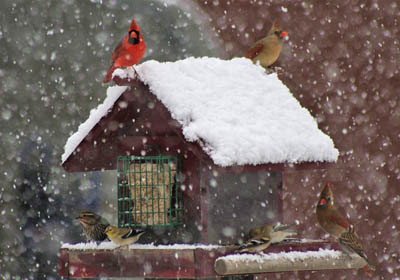



Very informative. I buy a bird feed wiht millet in it. I did not see millet mentioned. What about Millet?
Yep. That is in the mixed seed I talked about–white proso millet.